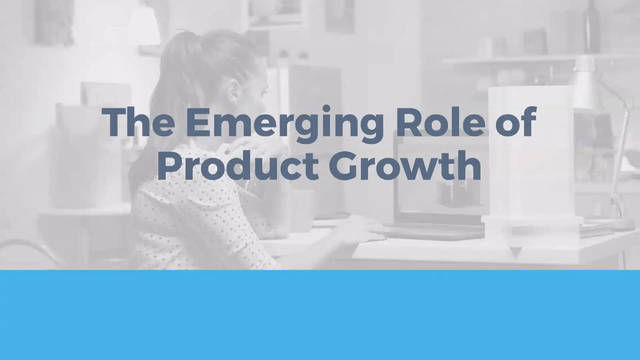The product growth wave is swelling, and it’s poised to slam into SaaS companies of all types. This product-focused approach isn’t just changing how SaaS businesses sell; it’s redefining the way the whole company operates.
For product leaders and managers, now’s the perfect chance to embrace product growth, and tap into its benefits, as the strategy reshapes the industry. Ready to start riding the product growth wave? In this article, we dig into the emerging role of product growth and show you how to use product growth to lead your company past its goals.
What is product growth?
Product growth is a SaaS strategy where you use your product to attract more users, drive higher engagement, and retain more customers. In the past, many SaaS companies relied on market-led growth or sales-led growth strategies. Within those frameworks, the main tactic was to reach out to as many new users as possible and attempt to snag one-off sales.
However, SaaS success now hinges on your ability to drive long-term use. Because most SaaS companies are built on subscription, freemium, free trial, and contract models, the key to growth now lies within your product—and the secret code sits in your user’s experience. Product growth dives into the user experience and uses product enhancements to lift satisfaction, increase referrals, drive upsells, and grow the product from the inside out.
Why are SaaS companies shifting focus to product growth strategies?
The focus for product growth has shifted from landing sales to boosting the user’s experience—and for good reason. More than two-thirds of companies now compete primarily on customer experience.
What’s causing this move towards user experience and product growth?
More and more, producing company success hinges on meeting customer needs. In fact, 84% of companies that focus on improving their customer experience reported an increase in revenue.
For SaaS companies, product-led growth strategies have become a cost-effective way to boost their user experience and catapult growth. And the entire tech space is racing to pick up product-led growth strategies. According to Gartner, by 2024, 80% of IT companies will radically change their missions and structure as they lean into product-centered operating models.
The propeller pushing this shift is a move in both customer demand and the market. Today’s users are tech-savvy, and they want software that they can run with. To satisfy that need, SaaS companies are focusing on enhancing their experience and giving them the tools they want.
Basically, the more you’re able to deliver a positive experience through your product, the more consumers pass on the good news or pull the trigger on upgrades―and the faster your product will grow.

What are the benefits of product-led growth?
It’s clear product-led growth is a boon for business, but what about product leaders and managers? There are also big benefits product teams are seeing with product-led growth strategies. Here are a few:
- Better Decisions: Product-centered growth roots your strategy in user information. For product managers and leaders, that means you have a guiding light to craft a product roadmap and nail down priorities.
- Happier Customers: Because product-led growth focuses on the customer experience, it automatically aligns your strategy with user and customer needs. For product leaders, this anchors your plans in the customer experience and helps guarantee the changes you make are serving a happier customer base.
- Lower Costs: By tapping into your current user’s experience and making enhancements, you see higher long-term returns without having to spend so many resources on attracting and nurturing new customers.
How do you implement a winning product growth strategy?
Product-led growth isn’t just becoming the norm in the SaaS world; it’s paving the way for a new function of product growth. By focusing on enhancing the user’s experience, it’s opening the door to completely new growth opportunities … as long as it’s done right. Here are some tips to consider if you want to craft a winning product growth strategy:
Fuel decisions with analytics.
Not all product leaders and managers realize how much valuable information is sitting within their product. By digging into user behaviors, customer feedback, and in-product analytics, you can back decisions with data. At the same time, you ensure your growth strategy stays in line with your user’s and customer’s experience.
Construct rock-solid customer feedback loops.
When you embed customer feedback loops into your user’s and customer’s experience, it feeds you decision-making data, keeps your users involved, and gives you a way to test moves. These mini-cycles promote growth by aligning your product enhancements with the customer experience. That will ultimately boost your reputation, increase referrals, and spark more sign-ups.
Create an engagement machine.
Adoption and higher engagement are key to lifting retention. After all, the more your users are interacting with features, the higher your product’s value rises. You can build an engagement machine by tracking in-product metrics, such as path analysis, identifying sticky features, and dropping in-app engagements into your product experience to remove any friction between users and features.
Experiment, test, and adjust.
True growth takes experiments, testing, and constantly adjusting to meet your user’s needs. By monitoring product KPIs, you can see how your product enhancements and features are affecting long-term goals. With that info in hand, you’ll have the recipe for growth.
Learn More About Product-Led Growth Strategy
Now that you have a basic understanding of product growth and its importance, download our e-book, Product Led Success: The Professional’s Handbook for a look at how businesses are thinking about how to scale while improving customer experience to match rapid growth.



